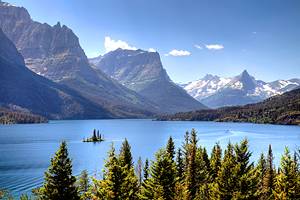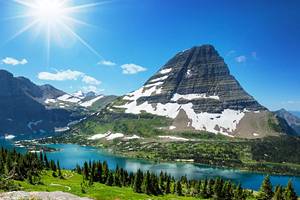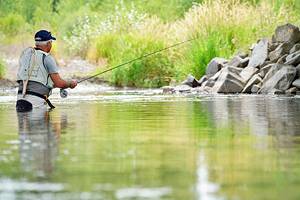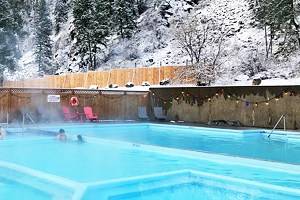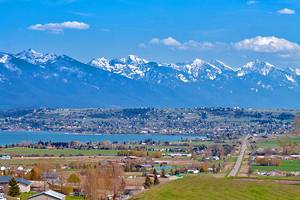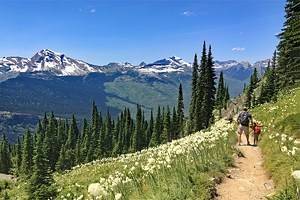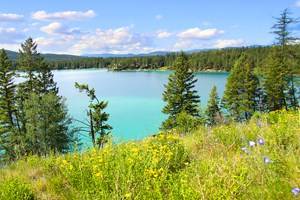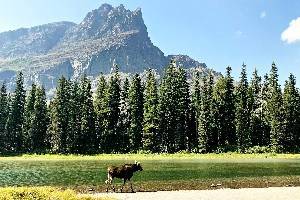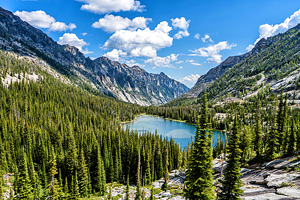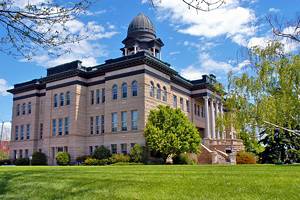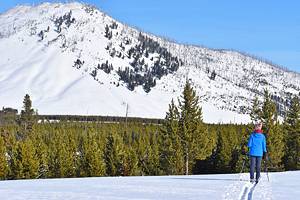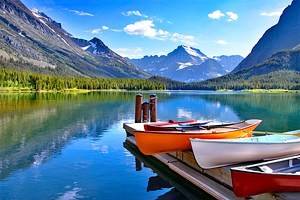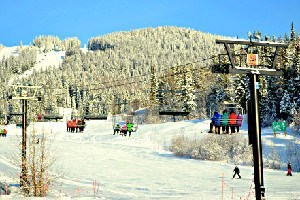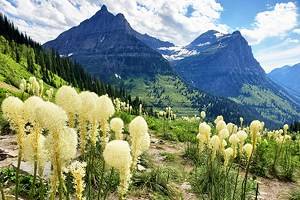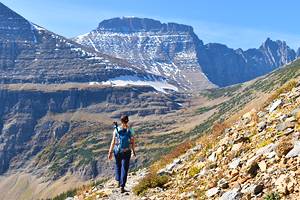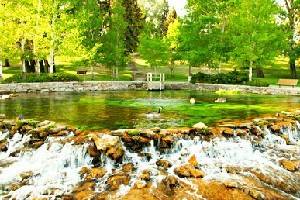Rivers for White Water Rafting in Montana
Author Brad Lane lived in Montana for nearly three years and enjoyed white water adventures during the summer months.
Montana is well known for outdoor adventure. Alongside glaciated mountains and dense forests, the state's wild rivers also get a lot of attention. While some prefer to wade out into Montana's rivers and cast a fly line, adrenaline seekers opt for white water rafting instead.
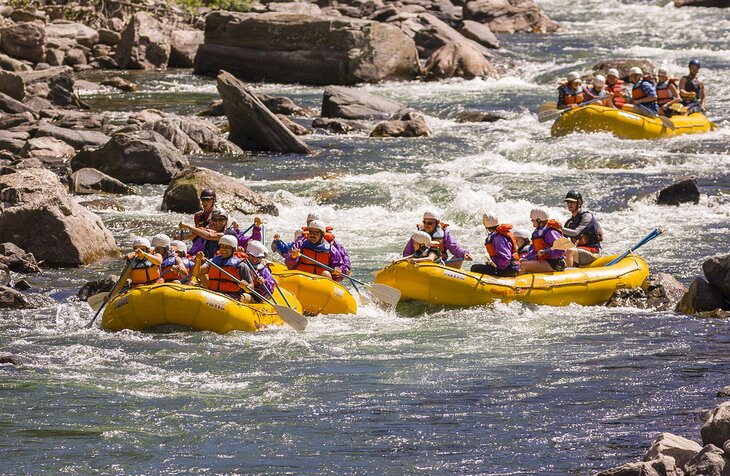
Yellowstone National Park and Glacier National Park, two of the most iconic landscapes in Montana, have white water nearby. Yellowstone has several wild rivers that originate in the park's high elevations and cascade throughout Montana. These rivers surrounding Yellowstone and Glacier make for a great add-on vacation when visiting either national park.
Several other rafting rivers flow through southern and southwest Montana. Both Missoula and Bozeman have white water within an hour, adding further appeal to these university cities.
The enitre rafting season in Montana spans from April through September. The prime time to hit most rivers for white water, however, is late spring and early summer.
For a little more foam on your next adventure, check out our list of the best rivers for white water rafting in Montana.
Flathead River
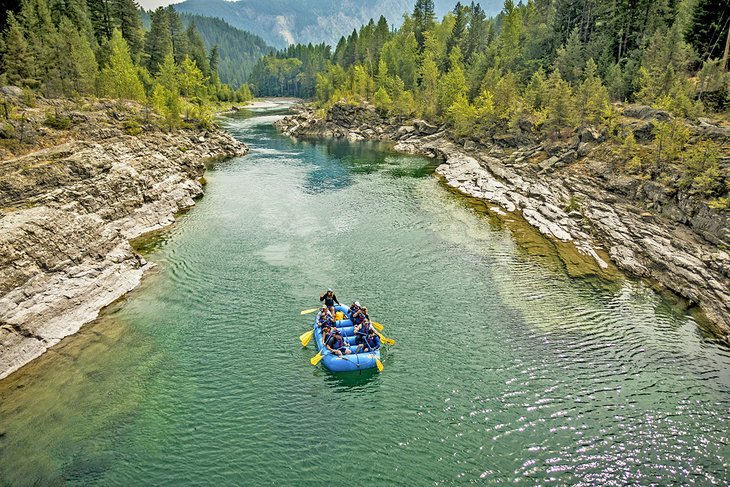
The Flathead River flows from the Rocky Mountains of northwest Montana and Canada. The river forms three waterways on its journey to create some of the country's most scenic river corridors. Two of these waterways, the Middle Fork and North Fork of the Flathead River, provide excellent white water conditions.
The Middle Fork and North Fork form the southern and western boundaries of Glacier National Park. With no rafting allowed inside the park, these picturesque rivers give the best view of Glacier's landscapes from a raft. A handful of rafting companies operate on either river throughout the summer.
Of the two, the Middle Fork tends to see a little more action. The beginning of the river flows through the expansive Bob Marshall Wilderness Complex. This section is only accessible via non-motorized transportation. After departing the wilderness near Essex, the Middle Fork runs alongside Highway 2 and the southern border of the national park.
This section of the river next to Highway 2 is where all guided trips take place. Trip lengths vary on the Middle Fork thanks to an abundance of roadside pull-outs.
One of the most popular and challenging sections of the river is from Moccasin Creek to West Glacier. This seven-mile stretch is also known as John Stevens Canyon. It features several Class II-III rapids in succession.
The North Fork of the Flathead River originates in British Columbia and cruises across the border to form Glacier's western edge. The North Fork is a wild river that barely ever passes through a town, except the small community of Polebridge in northwest Montana. The white water is a bit calmer on the North Fork, generally staying at Class I-II, but the ruggedness of the river makes for a real sense of adventure.
Yellowstone River
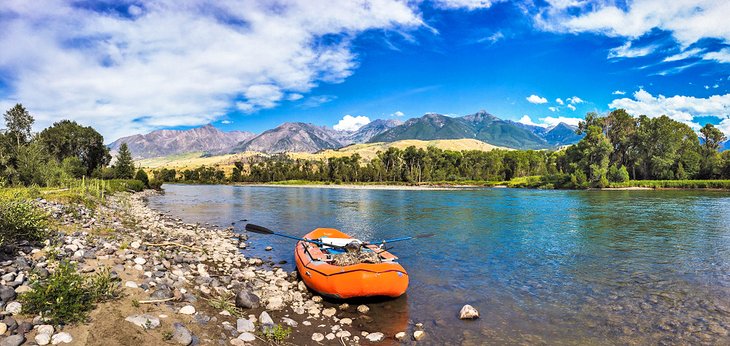
The Yellowstone River is one of the longest free-flowing rivers in the contiguous United States. This dam-free waterway spans over 670 miles from Yellowstone National Park to the Missouri River in North Dakota. The river has an intense scenic beauty that, for many, is the epitome of Montana.
Much of the waterway is well-regarded for quality line casting potential, making the river one of the best fly fishing spots in Montana. And, sections of the Yellowstone River have a particular froth in the summer months that makes them a hot spot for white water adventure.
White water adventures on the Yellowstone River begin just outside the national park in Gardiner. The river runs through Paradise Valley from here, surrounded by the beautiful Absaroka Mountains. Several commercial outfitters run boats out of Gardiner, with trips spanning either eight or 18 miles.
The 18-mile trips run through the most challenging part of the river known as Yankee Jim Canyon. This Class-III section features quick-moving rapids with names like "Yankee Jim's Revenge" and "The Pinch."
The Yellowstone River is one of the top attractions of Yellowstone National Park. While white water rafting isn't allowed within the park, big views at the Grand Canyon of the Yellowstone are readily available. The Yellowstone River's plunging waters offer one of the most beautiful river scenes in the American West.
Alberton Gorge, Clark Fork River
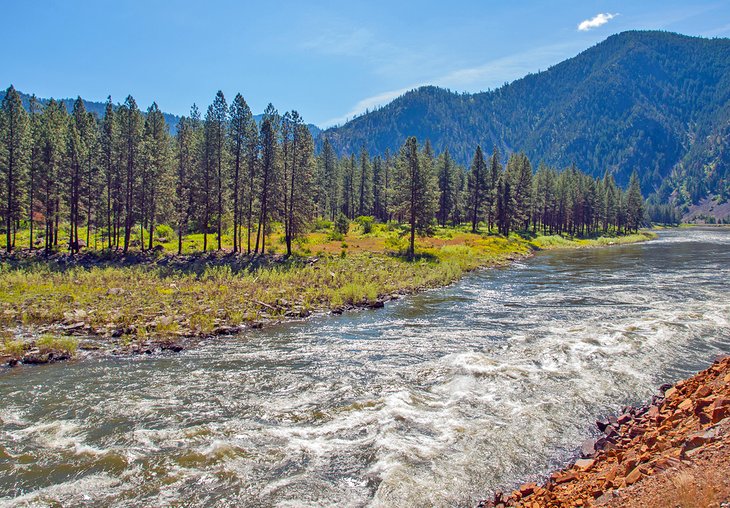
The Clark Fork River stretches for over 280 miles through southwest Montana. This surging river has undergone extensive rehabilitation over the past decade. Today, the Clark Fork features crystal-clear waters that are popular for fly fishing.
The river runs through the heart of the University of Montana campus in Missoula—one of Montana's best cities.
Activities like fishing and flatwater tubing take place along much of the river's length. The Clark Fork only has a relatively small portion of white water. Whenever someone mentions rafting on the Clark Fork, they are talking about the Class III rapids in Alberton Gorge.
Thirty-five miles downriver from Missoula, Alberton Gorge has adrenaline-inducing rapids between scenic sections of flatwater. Several commercial outfitters based out of Missoula run trips down this section of the river. Trip lengths vary between half- and full-day adventures.
Members of the public have several options for launching into Alberton Gorge. The town of Alberton, itself, is a good access point, though most boaters head for the Cyr Bridge.
The gorge features several Class III rapids that most intermediate paddlers should have a blast navigating. Two of the most common take-outs on the river are at the Trakio or Forest Grove boat ramps.
For a little white water action within Missoula's city limits, locals and visitors head to Brennan's Wave downtown. This human-made wave, named after a local kayaking legend, offers the chance to surf near the downtown Higgins Bridge.
Gallatin River
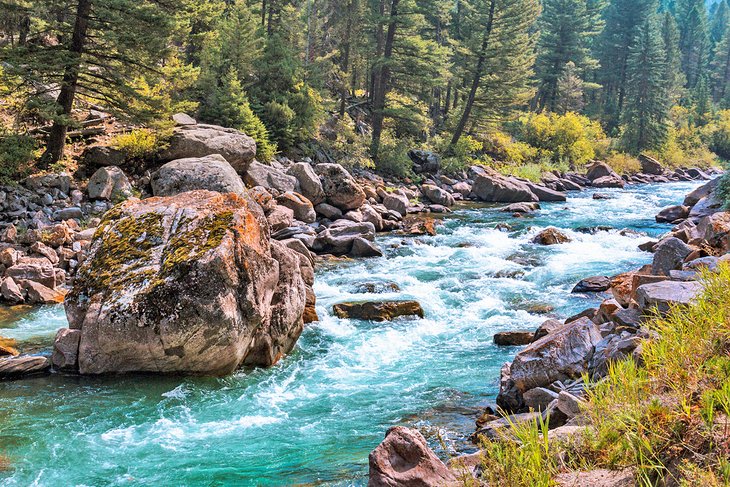
The Gallatin River spans for over 100 miles through Yellowstone Country in southern Montana. The river originates in Yellowstone National Park and parallels Highway 191 past Big Sky and towards Bozeman.
The Gallatin finds its terminus at the Missouri River in Three Forks. This scenic river provides ample opportunities for fly fishing and a few sections of iconic Montana white water.
Most Gallatin River trips start near the town of Big Sky. Several commercial outfitters run trips out of this adventure destination—home to Big Sky Resort. Outfitters and individuals alike run a half- or full-day adventures on two sections of the river. The most challenging part of the river is the lower section, where boaters encounter House Rock Rapid.
House Rock on the lower white water of the Gallatin is a rapid not to be missed. It's one of many Class III-IV rapids that makes this section iconic in Yellowstone Country. Other iconic features like the Mad Mile are particularly rampant during June and July.
The upper portion of the Gallatin River also provides some waves but is less heart-stopping than the lower. Trips on this section offer a little more time to check out the spectacular mountain scenery. Rafters on the upper can still expect some Class II-III rapids to test their paddling skills. Alternatively, rafters can raft all the Gallatin's white water on a full-day trip.
Many guiding companies also offer scenic floats on the Gallatin with limited splashing and white water. These trips savor the flavor of the rocky Gallatin River Canyon, with animal sightings often included.
Blackfoot River
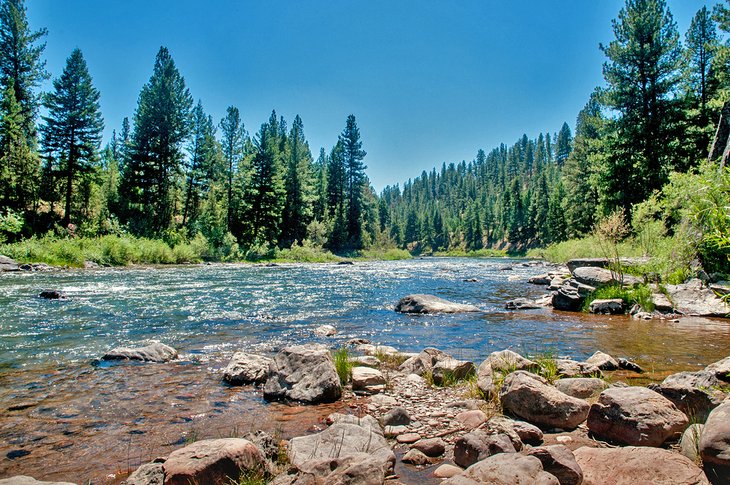
The Blackfoot River has claimed a special place in the lore and mythology of Montana. Memorialized by the 1976 book by Norman Maclean, A River Runs Through It, anglers across the world know this river for its excellent fly fishing. For white water enthusiasts, the fast-moving river also leads to a variety of rafting conditions.
The river runs for over 100 miles from the Continental Divide to the Clark Fork River near Missoula. Access to the river is relatively easy. A common spot to raft occurs on the 30 miles designated as the Blackfoot River Recreation Corridor. This scenic section spans from Russell Gates Memorial Campground to Johnsrud Park, with several Class II-III rapids along the way.
By mid-to-late summer, water levels decrease the rapids on the Blackfoot. This lower water level provides other fun technical challenges as more rocks start to reappear.
Several commercial outfits run trips out of Missoula, less than an hour away. Much of the white water on the Blackfoot parallels Highway 200. Several pull-outs on the highway make for variable distance trips. Commercial trips offer half- and full-day experiences.
Alongside fishing and white water, the Blackfoot River is also popular for good ole' fashion floating on an innertube. Missoulians often flock to the river to float the day away and beat the summer heat. The mountains surrounding the Blackfoot offer some of the best floating scenery in the state. And, wildlife often makes an appearance when fellow tubers aren't too boisterous.
Madison River
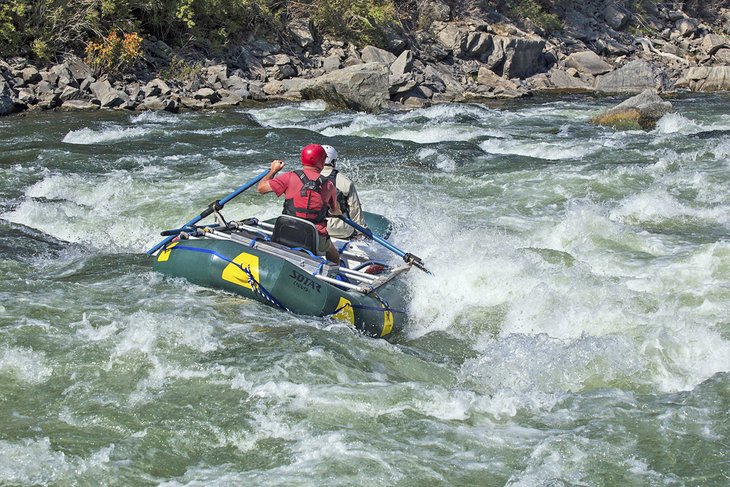
The Madison River passes quintessential Western landscapes as it ambles through Yellowstone Country in southern Montana. The river originates in Yellowstone National Park. The park hydrothermally heats the cold mountain water before it ventures north to meet the Missouri River in Three Forks.
Anglers around the world know the Madison River for its excellent fly fishing. The "Upper Madison," past the town of Ennis, is where the most fish meet the hook.
Beyond Ennis and Ennis Lake, the river enters the remote and scenic Bear Trap Canyon. This canyon is the place to find the longest stretch of white water on the Madison River.
Bounded by tall canyon walls and punctuated with big boulders, Bear Trap Canyon offers Class III-IV rapids. Only a few outfitters run trips through Bear Trap Canyon, which takes a full day to complete.
Boaters typically put in at the Madison Dam and paddle for 10 miles. Class II-III rapids at the beginning of the run are a good warmup for the river's real challenge: the Class IV Kitchen Sink Rapid.
The Madison River also provides an earthquake-induced section of white water. In 1959, a massive earthquake rocked the region, resulting in a deadly rockslide that buried an active campground and blocked the river. An outlet for the river was dug in the newly created Quake Lake, resulting in a steep section of white water.
Boaters looking to enjoy this year-round white water below Quake Lake should expect Class III-IV rapids. This section of the Madison River is not for beginners and has several spots where exiting the boat and swimming is dangerous. One notorious rapid in this section, known as S-Turn Rapid, is Class V and has an available portage to the left.
Stillwater River
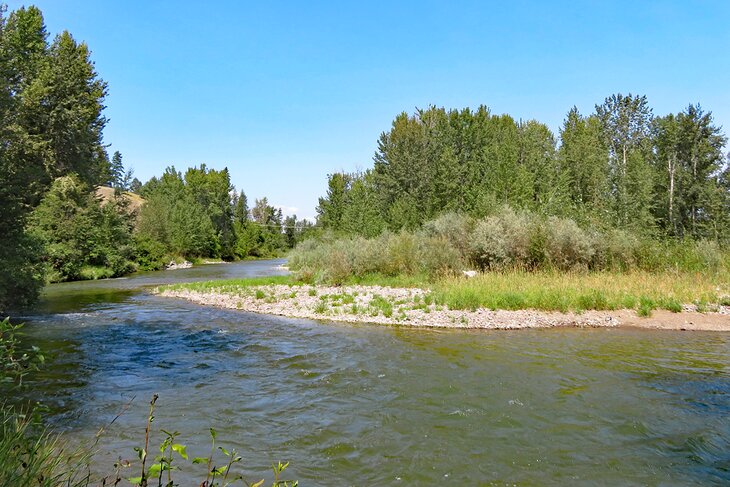
The Stillwater River in southern Montana does not live up to its name. The river originates within the high elevations of the Absaroka-Beartooth Wilderness. From here, the river steadily drops on its journey to meet the Yellowstone River near Columbus. Several sections of white water on the Stillwater entice boaters from across the country.
The Upper and Lower Stillwater are the two most popular sections of the river to paddle. The Upper Stillwater has at least four recognized runs spanning from the Old Nye Picnic Area to the Johnson Bridge fishing access. This length of river runs through Custer-Gallatin National Forest and offers Class III white water.
The Lower Stillwater also features some classic runs. The rapids are a little less stressful on the Lower. Boaters still need to keep their wits with rapids like Swinging Bridge Rapid and Beartooth Drop. A common attribute of both the Lower and Upper sections is the beautiful Yellowstone Country surrounding the riverbanks.
The Stillwater really defies its name with the big waves of the Woodbine section of the river. Above the Upper Stillwater, closer to the headwaters, this 3.5-mile section is for experienced boaters only. Alongside massive boulders and Class V features like Aqua Velvet, the Stillwater is anything but stationary.
Smith River
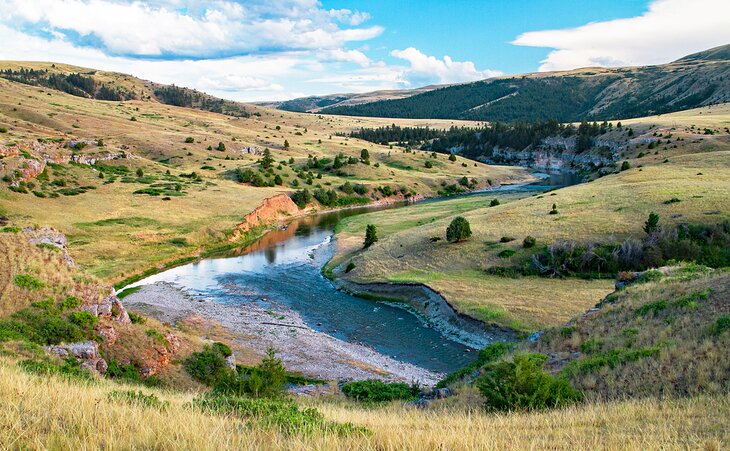
The Smith River offers an iconic multi-day river adventure stretching for approximately 60 wilderness miles in the central part of the state. It's a mellow river with very few rapids. This gives the Smith River a better reputation for multi-day float trips, and especially multi-day fly fishing trips.
While the Smith might not pack the same Class-IV adrenaline as bigger white water rivers, it's highly regarded as one of the best float trips in the state. So much so that it's one of the few rivers that require a permit to float from Montana, Fish, Wildlife & Parks.
The classic route spans approximately 60 miles from its put-in at Smith River State Park near White Sulphur Springs. There's no other takeout along the entire stretch of the river canyon until reaching Eden Bridge 60 miles downriver. This single entry and exit point keep the river uncrowded, as does the permit system.
Most floaters and anglers navigate the Smith River over the course of four days. The typical float season spans between mid-April and July 4th. Permits are required throughout the season. While the river is fairly mellow, the route navigates exclusively remote wilderness areas. Previous paddling experience is recommended.


